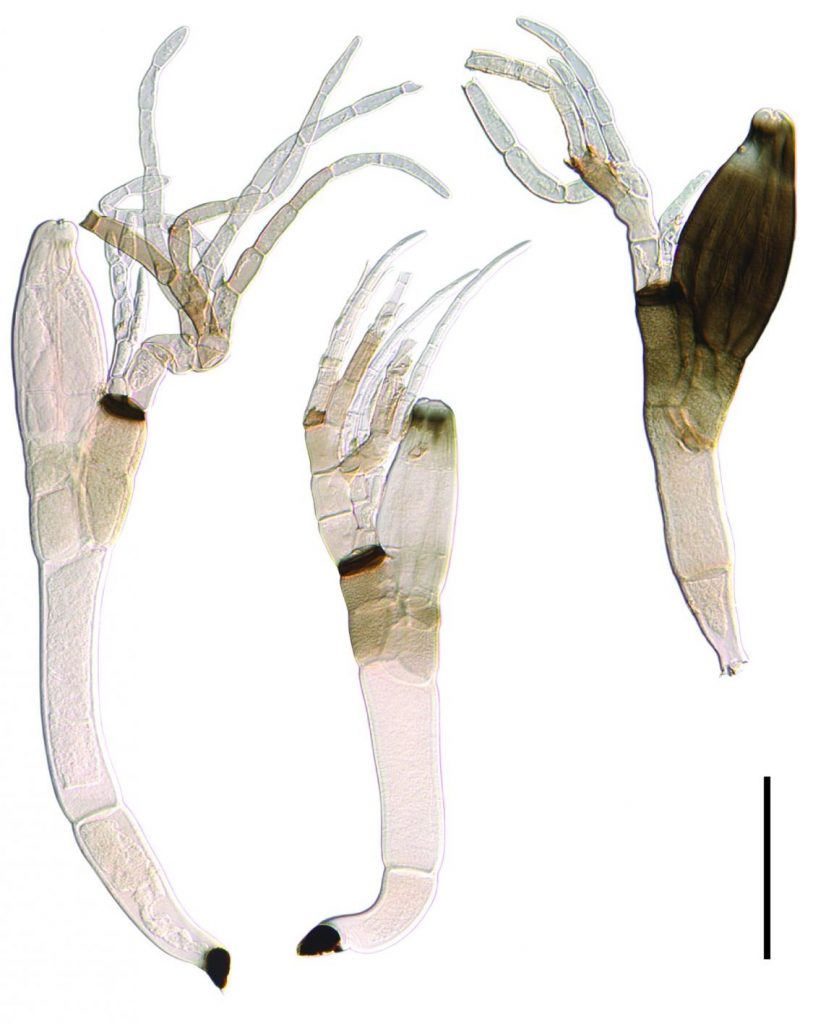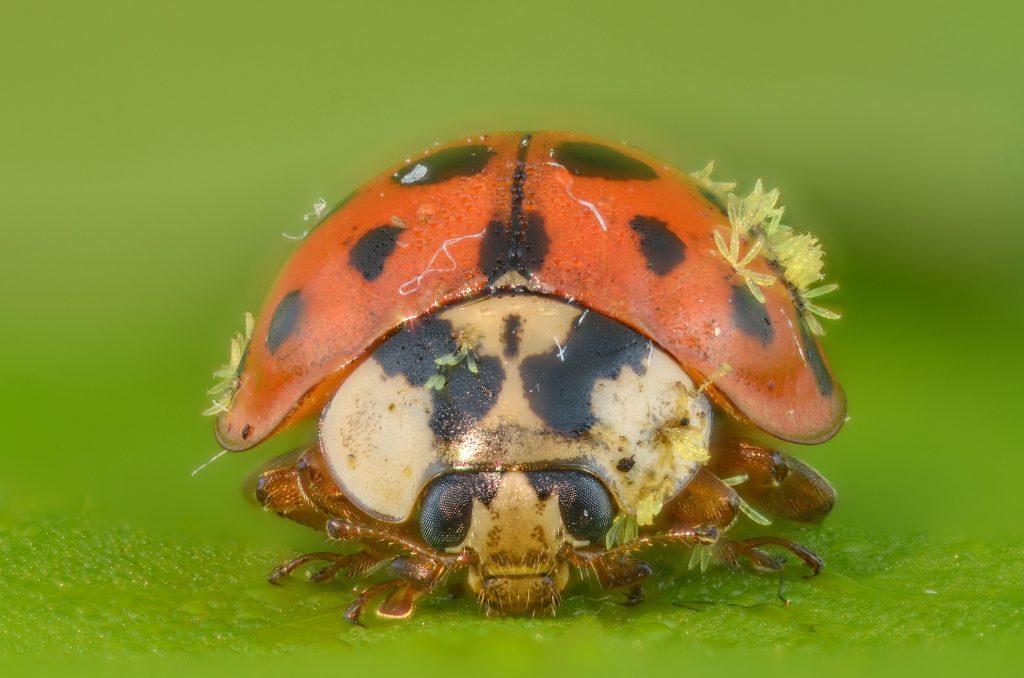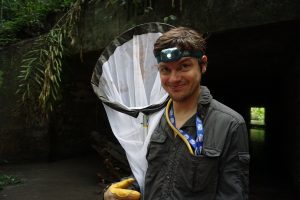Dr Danny Haelewaters – Shining New Light on the Complex World of Fungi
From microscopic, single-celled yeasts to a mycelium that can cover many acres underground, fungi represent a diverse array of organisms. However, despite their global distribution, diverse growth forms, and complex interactions with other organisms, we still know very little about fungi. This lack of knowledge is reflected in the numbers: although it is estimated that there are between 1.5 and 6 million species of fungi, only around 138,000 have been described. Dr Danny Haelewaters of Ghent University is contributing to closing the gap in our understanding. His team’s research explores the diversity of fungi, in addition to their evolutionary history and ecological interactions with other groups of organisms.
An Understudied Kingdom
Although most people immediately recognise mushrooms, with their well-known cap and stem, many other fungi, such as yeasts and moulds, are microscopic. Despite their importance, many of these fungi have been overlooked, with millions of species still awaiting description.
‘Fungi are essential to ecosystem functioning, they occur virtually everywhere and form complex mutualisms with diverse organisms including prokaryotes, algae, plants, invertebrates, vertebrates, and other fungi,’ says Dr Danny Haelewaters, a researcher at Ghent University in Belgium, who studies the classification, biology, and ecology of fungi.
Dr Haelewaters has contributed substantially to known fungal diversity, describing and documenting more than fifty new species. One microscopic fungus, discovered and described by Dr Haelewaters, is Laboulbenia quarantenae, which he named after the lockdown measures that were in place at the time due to the global COVID-19 pandemic. Although the pandemic caused much of Dr Haelewaters’ field studies to be cancelled, it serendipitously gave him and his colleague the time they needed to finally describe the species.
Describing new fungi such as Laboulbenia quarantenae is of interest to not only mycologists, but for anyone interested in ecological conservation and maintaining biodiversity. Some fungi, for example, are critical to the health and survival of plants. Others provide essential ecosystem services, such as the decomposition of matter into available nutrients for plants and animals. However, we cannot truly understand the role of fungi – or which fungal species are threatened – unless we first document their existence, understand their evolution, and study their basic biology. Armed with this knowledge, conservationists would be able to devise more effective strategies for protecting important fungal species, and their wider ecosystems.
Therefore, Dr Haelewaters has dedicated much of his career to researching two understudied classes of fungi: Laboulbeniomycetes and Leotiomycetes.
The class Laboulbeniomycetes is a unique group of fungi that form obligate relationships with insects and other arthropods. However, due to their microscopic size, peculiar morphologies, complicated life history, and the inability of many species to be grown in culture, they have been mostly neglected by mycologists. While Laboulbeniomycetes present a variety of challenges that preclude research, descriptions of species within the class Leotiomycetes have been comparatively extensive. However, attention has been mainly focused on species in the Northern Hemisphere, whereas the tropics, Africa, and Asia have been virtually unsampled.
In addition to describing new fungal species, Dr Haelewaters has also creatively used and in some cases developed new tools and technologies. When combined with traditional classification methods, his techniques have elucidated complex evolutionary relationships among species in these two classes of fungi. His current work has now branched into the ecological implications of the associations that fungi make with other types of organisms – leading to a whole new area of community ecology research, in which he asks questions about how climate and habitat may affect these associations.

Thalli of Laboulbenia quarantenae, named after the COVID-19 quarantine period. Scale bar = 0.1 mm. Photo: André De Kesel.
Evolution of Parasitic Fungi
Of all fungi, parasitic fungi are perhaps the most understudied. The most diversified group of fungi within the Laboulbeniomycetes class is Laboulbeniales. This is an order consisting of fungi that live as external parasites on arthropod hosts. As ‘obligate parasites’, they must associate with a host in order to survive and reproduce. Colloquially known as ‘beetle hangers’, these tiny fungi appear to ‘hang’ from many arthropod species – mostly beetles – by attaching to their bodies. With 2,325 known species and many more awaiting descriptions, the Laboulbeniales order is quite species-rich.
Laboulbeniales can parasitise a wide range of arthropod hosts, including beetles, mites, millipedes, cockroaches, earwigs, and flies. Despite this broad host diversity, most of these fungi exhibit strict host specificity, with each species of fungi associating with only one species of host. However, some Laboulbeniales species are habitat-specific rather than host-specific, having multiple hosts that are in unrelated groups yet occur in the same habitat, such as underground caves or ant nests.
The unusual morphologies and microscopic size of Laboulbeniales species makes them difficult to study. This difficulty is compounded by the fact that, contrary to most fungi, researchers have not been able to grow Laboulbeniales in culture. Consequently, the relationships between Laboulbeniales and other members of its class, Laboulbeniomycetes, are still not well understood.
While previous research has mainly characterised Laboulbeniomycetes by grouping species based on their physical attributes, Dr Haelewaters was among the first to combine morphological methods with modern genetic sequencing and molecular tools, as well as ecological information, to evaluate their evolutionary history. Using this method on a parasitic fungus of ladybirds, he found that each ladybird species has its own unique species of fungus. This approach has also led to other fascinating discoveries. For example, Dr Haelewaters developed the first evolutionary tree of Laboulbeniomycetes based on multiple molecular markers, which describes how species in this group are related to one another and how they diversified. During this work, Dr Haelewaters established a new order, the Herpomycetales, to accommodate species that are exclusively associated with cockroaches.
Though Dr Haelewaters’ contributions have been significant, he is dedicated to deepening our understanding of the evolutionary history of Laboulbeniomycetes further. ‘Resolving evolutionary relationships among Laboulbeniomycetes is a long-term pursuit that I will continue to develop,’ he says. To do so, he received funding to sequence an additional 25 fungal genomes.
Alongside their use of technological tools, Dr Haelewaters and his colleagues also connect concepts from theoretical ecology and fungal morphology, to make predictions on how morphology and distribution might influence host specificity. For example, some Laboulbeniales species penetrate the host tissue using a structure known as a haustorium, while others simply attach to the surface of their host’s body. Dr Haelewaters hypothesises that, as hosts develop defence mechanisms, these fungal parasites with a haustorium adapt accordingly, which can lead to the evolution of new species. In other words, species with a haustorium are highly host-specific.
‘Fungi are essential to ecosystem functioning, occur virtually everywhere, and form complex mutualisms with diverse organisms including prokaryotes, algae, plants, invertebrates, vertebrates, and other fungi.’

Ladybird infected by a species of Laboulbeniales. Photo: Bart Horvers
Parasites of Parasites
As obligate parasites, our understanding of the Laboulbeniales is only as good as our understanding of their host relationships. Since 2015, Dr Haelewaters has investigated the species-level diversity of Laboulbeniales associated with flies that parasitise bats. Between 2015 and 2020, Dr Haelewaters conducted field studies in Honduras and Panama, which resulted in the discovery of six new species of fungi being described and thousands more bat flies being added to a large repository of over 12,000 bat fly samples. His activities in Panama have led to a long-term collaboration with researchers at the Universidad Autónoma de Chiriquí to mentor students and investigate the local Laboulbeniales diversity.
This tripartite relationship between bats, bat flies, and parasitic Laboulbeniales fungi is globally common. Collaborating with Operation Wallacea and Taxon Expeditions, two networks of academics who implement biodiversity research expeditions with students and citizen scientists, Dr Haelewaters and his team are starting to monitor bats for the presence of bat flies in field sites in Central and South America, Europe, Africa, and Asia.
Dr Haelewaters and his colleagues plan to keep building on their repository to see if there are certain traits that are correlated with parasitism. For example, the researchers have already reported data indicating that local temperature and humidity influence parasitic prevalence of Laboulbeniales on their hosts. With human-induced habitat fragmentation altering ecosystems worldwide, it may be speculated that parasitism by Laboulbeniales could become more widespread in the future. The team hopes to continue to sample bats and bat flies to have a more robust repository of data, so that they can better understand the possible impacts of climate change and habitat fragmentation on Laboulbeniales fungi and their hosts.

Gloeandromyces, which Dr Haelewaters discovered on a bat fly in Panama. Scale bar = 0.1 mm
Describing New Fungi
One of the largest questions in mycology is: What are the millions of fungi that have not yet been described, and where are they found? The Leotiomycetes class, understudied in Asia, Africa, and the tropics provides an excellent opportunity to examine both questions.
Dr Haelewaters is now part of an international team leading research into this class and is pioneering efforts to sample for species in previously unvisited areas. For example, Dr Haelewaters and his team received an EU INTERACT Transnational Access grant to sample peat bogs in Siberia, and funding from the United States National Science Foundation to support research in Mozambique, Ireland, and Central America.
Additionally, Dr Haelewaters started a long-term fungal survey at Cusuco National Park in Honduras in 2019 and has thus far collected over a hundred specimens, of which eleven likely represent undescribed species. Such a long-term study has the potential to greatly expand our understanding of fungal diversity, and – again – to evaluate the long-term effects of habitat disturbance due to climate change and activities such as deforestation.
Broader Implications
Understanding what type of species exist and where they are found is integral to creating and implementing conservation goals. Beginning to classify the millions of undescribed fungal species and their interactions with other organisms will expand our understanding of fungal diversity and their ecological roles.
Dr Haelewaters has contributed not only to sampling for these species, but in prioritising understudied areas and using modern-day tools and technologies that allow for fungal diversity to be placed in an evolutionary context. By expanding our knowledge of fungal species, including their evolution and complex ecological roles, conservationists will be far better equipped to protect Earth’s precious biodiversity for future generations.
Reference
https://doi.org/10.33548/SCIENTIA728
Meet the researcher

Dr Danny Haelewaters
Department of Biology
Ghent University
Ghent
Belgium
Dr Danny Haelewaters started off his career with an interest in animal science, and achieved a Bachelor’s degree in Veterinary Medicine from the University of Antwerp in 2004. After the realisation that he did not want to work in a hospital setting, he discovered mycology, the study of fungi, and achieved a BSc and MSc in Biology at Ghent University. This was followed by a PhD in Organismic and Evolutionary Biology at Harvard University. He spent two years at Purdue University, where he was employed as a postdoctoral research assistant on a project to characterise the fungal microbial community of romaine lettuce. Dr Haelewaters is currently back at his alma mater, Ghent University, as a junior postdoctoral fellow. He is also currently a researcher at the University of South Bohemia and the Biology Centre of the Czech Academy of Sciences, both in České Budějovice, and holds an associate researcher position at the Universidad Autónoma de Chiriquí in Panama. Given his interdisciplinary background, it is no surprise that Dr Haelewaters has diverse research interests. Much of his work involves clarifying the evolutionary relationships of Laboulbeniales, an order of fungi that parasitise insects and other arthropods. However, he is also fascinated by the ecological implications of the interactions that these fungi have with their hosts. Finally, Dr Haelewaters is passionate about expanding our knowledge of fungal diversity and has pioneered fungal surveys in understudied habitats. Along with his research interests, Dr Haelewaters is enthusiastic about science communication and mentoring the next generation of scientists.
CONTACT
E: danny.haelewaters@gmail.com
W: www.dannyhaelewaters.com
KEY COLLABORATORS
Catherine Aime, Purdue University
André De Kesel, Meise Botanic Garden
Carl W. Dick, Western Kentucky University
Thomas Hiller, University of Hohenheim
Thomas E. Martin, Operation Wallacea
Oldřich Nedvěd, University of South Bohemia
Rachel A. Page, Smithsonian Tropical Research Institute
C. Alisha Quandt, University of Colorado, Boulder
Rosa V. Villarreal Saucedo, Universidad Autónoma de Chiriquí
FUNDING
Research Foundation – Flanders, Belgium
National Science Foundation, USA
David Rockefeller Center for Latin American Studies at Harvard University, USA
The Linnean Society of London
The Systematics Association, UK
University of South Bohemia, Czech Republic
FURTHER READING
M Perreau, D Haelewaters, P Tafforeau, A parasitic coevolution since the Miocene revealed by phase-contrast synchrotron X-ray microtomography and the study of natural history collections, Scientific Reports, 2021, 11, 2672.
D Haelewaters, M Blackwell, DH Pfister, Laboulbeniomycetes: Intimate fungal associates of arthropods, Annual Review of Entomology, 2021, 66, 257–276.
D Haelewaters, CW Dick, KP Cocherán Pittí, K Dittmar, BD Patterson, Bats, Bat Flies, and Fungi: Exploring Uncharted Waters, In: Lim B.K. et al. (eds) 50 Years of Bat Research, Fascinating Life Sciences, Springer, Cham, 2021, 349–371.
D Haelewaters, N Schoutteten, P Medina-van Berkum, TE Martin, A Verbeken, MC Aime, Pioneering a fungal inventory at Cusuco National Park, Honduras, Journal of Mesoamerican Biology, 2021, 1, 111–131.
SC Gonçalves, D Haelewaters, G Furci, GM Mueller GM, Include all fungi in biodiversity goals, Science, 2021, 373, 403.



Want to republish our articles?
We encourage all formats of sharing and republishing of our articles. Whether you want to host on your website, publication or blog, we welcome this. Find out more
Creative Commons Licence
(CC BY 4.0)
This work is licensed under a Creative Commons Attribution 4.0 International License. 
What does this mean?
Share: You can copy and redistribute the material in any medium or format
Adapt: You can change, and build upon the material for any purpose, even commercially.
Credit: You must give appropriate credit, provide a link to the license, and indicate if changes were made.
More articles you may like
Dr Lifei Wang | Can Species Distribution Models Inform Us About Future Ecosystems?
The world is buzzing with news about how human activities and climate shifts are reshaping our ecosystems. Have you ever wondered how life will adapt to this rapidly changing world? Ecologists might be able to predict how different species will live in future using computer simulations. Dr Lifei Wang at the University of Toronto Scarborough investigates how different stimulations work under varying conditions to provide new insights into what may lie ahead.
Dr Yong Teng | Improving the Outlook for Head and Neck Cancer Patients
Dr Yong Teng at the Emory University School of Medicine is working with colleagues to overcome the high mortality of individuals diagnosed with cancers affecting the head and neck. One of his approaches is based on understanding the particular mechanisms of the ATAD3A gene, which new insights suggest are closely related to cancers affecting the head and neck.
Dr Tsun-Kong Sham – Dr Jiatang Chen – Dr Zou Finfrock – Dr Zhiqiang Wang | X-Rays Shine Light on Fuel Cell Catalysts
Understanding the electronic behaviour of fuel cell catalysts can be difficult using standard experimental techniques, although this knowledge is critical to their fine-tuning and optimisation. Dr Jiatang Chen at the University of Western Ontario works with colleagues to use the cutting-edge valence-to-core X-ray emission spectroscopy method to determine the precise electronic effects of altering the amounts of platinum and nickel in platinum-nickel catalysts used in fuel cells. Their research demonstrates the potential application of this technique to analysing battery materials, catalysts, and even cancer drug molecules.
Dr Michael Cherney – Professor Daniel Fisher | Unlocking Woolly Mammoth Mysteries: Tusks as Hormone Time Capsules
The impressive tusks found on proboscideans (the order of mammals that includes elephants, woolly mammoths, and mastodons) are like time capsules, preserving detailed records of their bearers’ lives in the form of growth layers and chemical traces. Frozen in time for thousands of years, these layers can unlock secrets about the lives of long-extinct relatives of modern elephants. Dr Michael Cherney and Professor Daniel Fisher from the University of Michigan used innovative techniques to extract and analyse steroid hormones preserved in woolly mammoth tusks. This ground-breaking work opens new avenues for exploring the biology and behaviour of extinct species.




